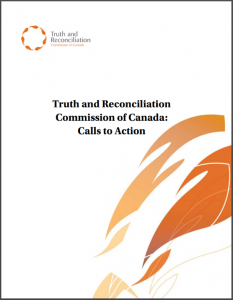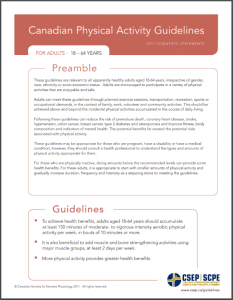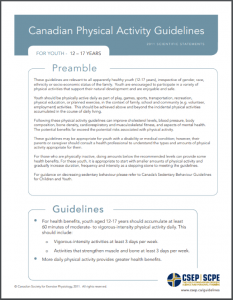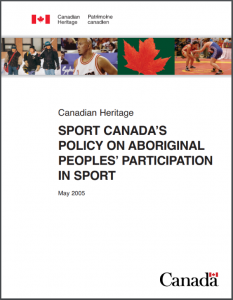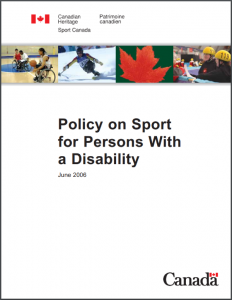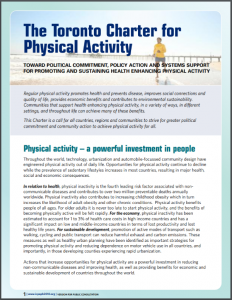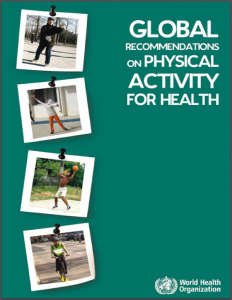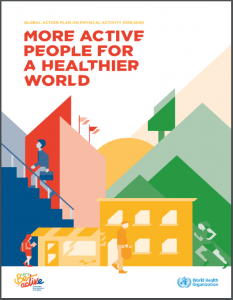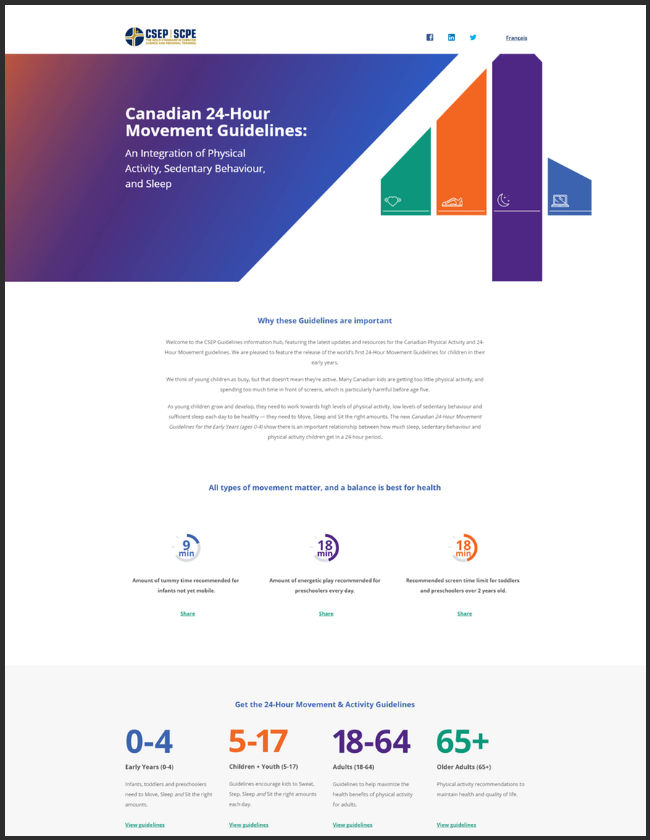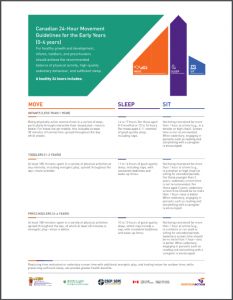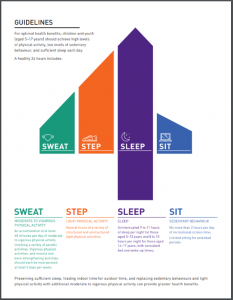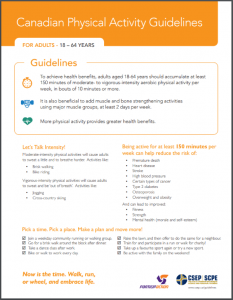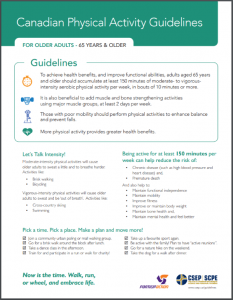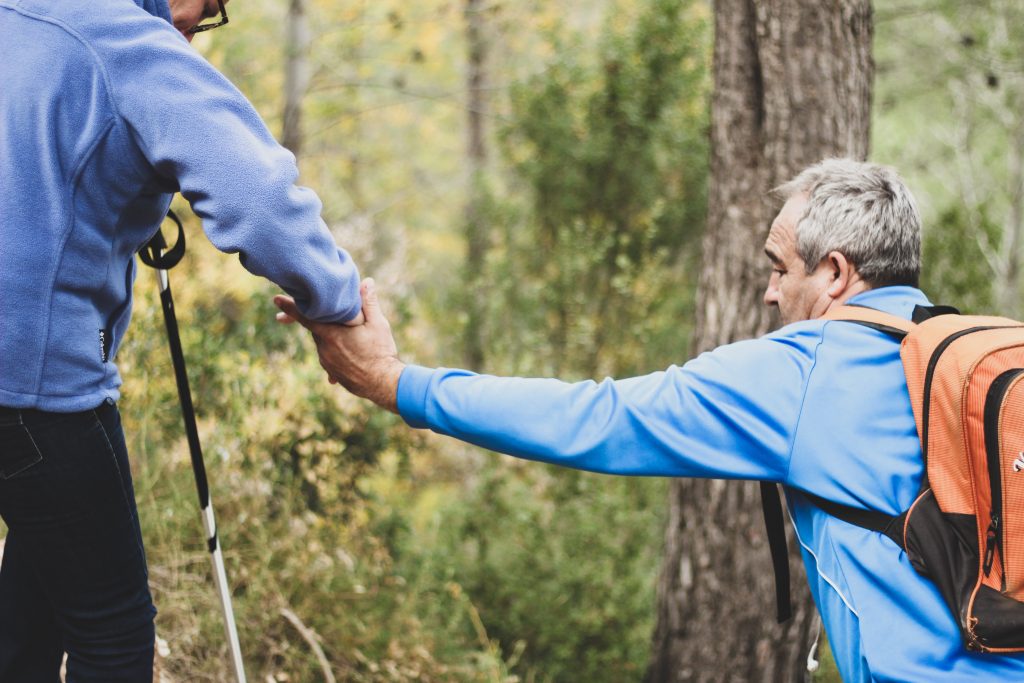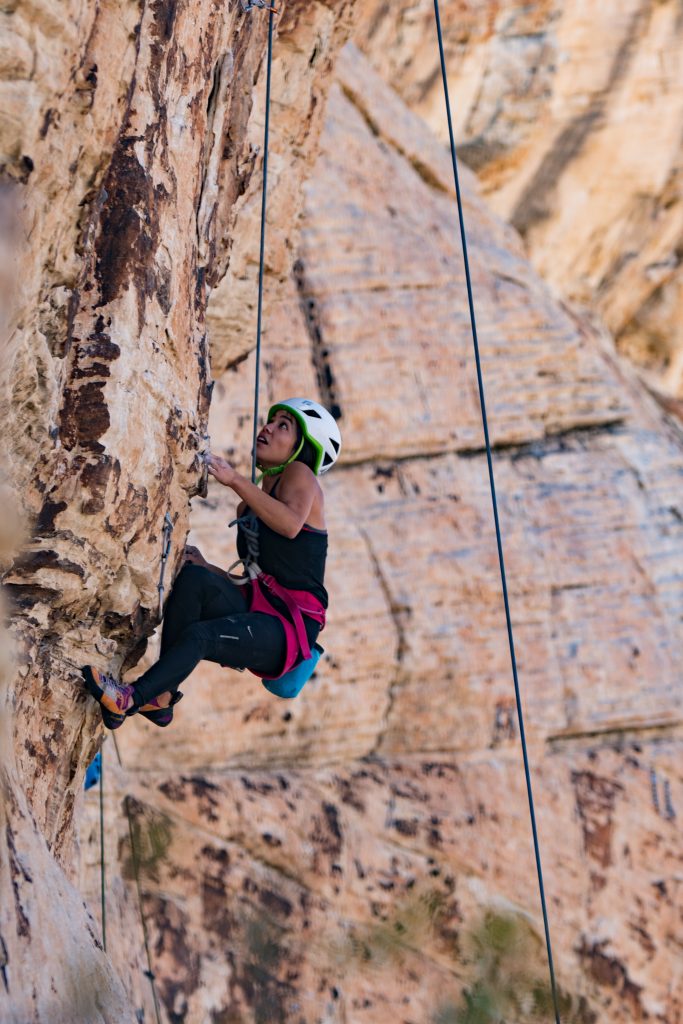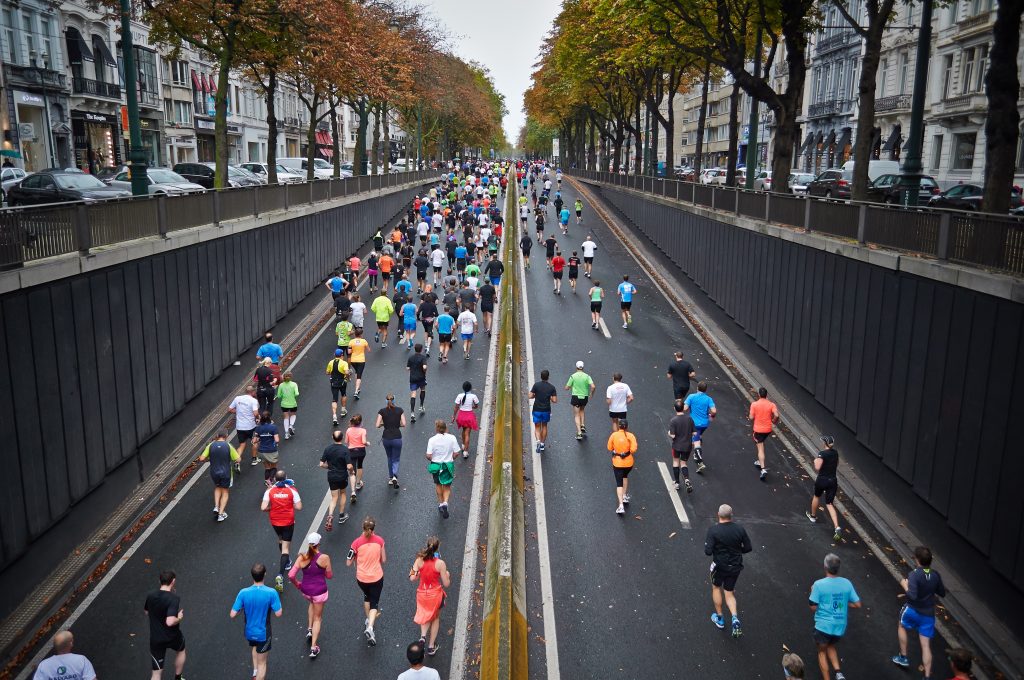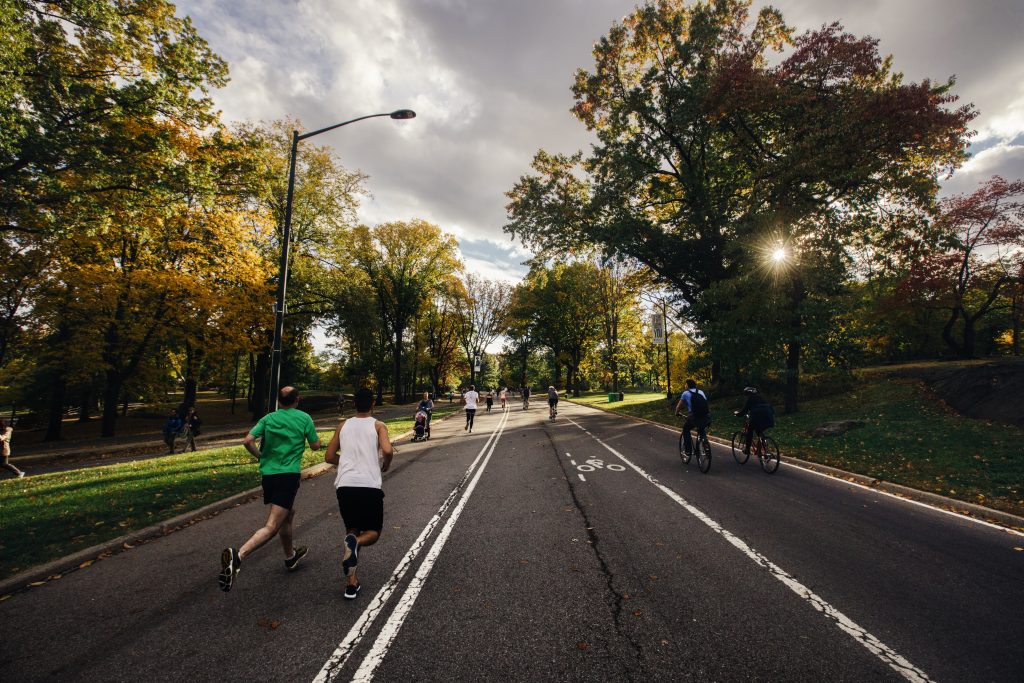Jump to:
The Active Alberta Coalition as Alberta’s common voice
In January 2019, WinSport and the Active Alberta Coalition were awarded a grant by Alberta's Minister of Culture and Tourism. In April 2019, under new provincial leadership, the grant was moved to the portfolio of Culture, Multiculturalism and the Status of Women to implement the Common Vision in Alberta's active living sector.
Sedentary lifestyles have become a global crisis. We are experiencing the effects on our physical and mental well-being, our culture and society, environments and government systems.
Noncommunicable diseases (NCDs) such as heart disease, stroke, diabetes, cancer, and other issues related to an overweight and/or obese population have reached extreme levels.1 According to Statistics Canada, in 2017 Canadians (between 3 and 79 years old) spent 554 minutes (9.23 hours) per day sedentary.2,3
We, as human beings, were not designed and built to live a sedentary lifestyle4. According to the Canadian Medical Association (2017), “the fallout from physical inactivity hits our pocketbooks. The estimated direct, indirect and total health-care costs of physical inactivity in Canada in 2009 were $2.4 billion, $4.3 billion and $6.8 billion, respectively."5
In May 2018 Canada's Department of Public Health released the Common Vision for Increasing Physical Activity and Reducing Sedentary Living in Canada: Let's Get Moving. The vision is to have "a Canada where all Canadians move more and sit less, more often."6
With many provincial, territorial and federal policies and plans to guide the active living sectors, the Common Vision is the first to incorporate them into a single initiative, geared towards getting Canadians healthy. Increasing physical activity levels and decreasing sedentary lifestyles is everyone's concern. These are complex issues with complex solutions; the solution is not found solely in the sport recreation, physical activity and health sectors.
The Active Alberta Coalition is ready to take on this diverse and complex issue and is invested in becoming a leader, as Alberta's common voice to bring awareness to the Common Vision. Our goal is to make Alberta the healthiest and most active population in Canada.
The information below is found in the Common Vision. The Common Vision is built on five interdependent foundational principles to get Canadians moving: Physical Literacy, Life Course, Population Approach, Evidence-based and Emergent-focused and Motivations. It includes six areas of focus: Cultural Norms, Spaces and Places, Public Engagement, Partnerships, Leadership and Learning, and Progress.
LET'S GET MOVING ALBERTA!
Building Alberta's Common Voice Through the Common Vision
Part I - The Context
Understanding the Common Vision
The Common Vision is the opportunity to have a Canada where all Canadians move more and sit less often.
"Never before has Canada had a singular policy focus on physical activity and its relationship to sport, recreation, health, as well as other relevant policy areas. What's more, this document also addresses the critical issue of sedentary living. It is a new, collective way forward that will guide the country towards ways of increasing physical activity and reducing sedentary living in Canada"
- Common Vision (Executive Summary)
Building on Our Strengths
Canada has a wealth of knowledge and know-how to build on, as well as the experiences and expertise of other countries and international organizations to help move the country forward. The Common Vision draws on the tenets, proven approaches and learnings from other relevant sport, physical activity, recreation, health related frameworks, strategies and reports.
The Common Vision is for you if you are:
Looking to increase your program/organizational effectiveness or are looking to improve the lives of Albertans and Canadians;
An organization, a member of community or a leader that has a stake in increasing physical activity and reducing sedentary living;
Aligning multiple policies, strategies and frameworks.
The Common Vision will also serve the goals and objectives of existing national, federal, provincial and territorial policies, strategies and frameworks on sport, physical activity, recreation and health, including:
Together we can:
Build awareness and take bold new steps together.
Consider ways to promote and share our investment in physical activity and the reduction of sedentary living.
Ignite a call to action so that all organizations, communities and leaders have an interest in promoting and supporting physical activity in all its forms in Canada and know that they have a role to play.
Change bad habits and the way too many live now.
People go out of their way to be physically active; make physical activity something that is done naturally during leisue time, at a gym or sports field.
Sedentary living contributes to poor health and even premature death, nearly 50% of Canadian adults are not physically active enough..
We spend too much time being idle, even those who meet the minimum daily physical activity requirements are too sedentary during the rest of the day.
Physical Activity
Any movement of the body produced by skeletal muscles that requires the expenditure of energy.
Examples:
- Sport and recreational activities
- Movement happens at home, school, work, during leisure time and when we are getting from place to place
- Rely less on automation
- Take the stairs
- Ride your bike
- Put the screens down
- Play outside
- Walk
- Promote traditional Indigenous Land-based activities - connecting to the natural environment
- Hunting
- Fishing
- Gathering
Sedentary Behaviour
Any waking behaviour characterized by low-level energy expenditure.
Related to body postures, such as sitting or reclining, in addition to low energy expenditure and physical inactivity
Common behaviours that individuals typically engage in while sedentary:
- Watching TV
- Driving to work
- Reading a book
- Sitting in classrooms
- Sitting on a couch
- Sitting at a desk
Even those who meet the minimum daily physical activity guidelines are too sedentary for the rest of the day.
Utilitarian Physical Activity
Physical activity engaged in for the purpose of accomplishing work, chores, errands or travel; in accordance with one's cultural values and practices.
Sedentary Behaviours Cost Us Money and Lives
Early research has found that sedentary living contributes to poor health and even premature death.21
Physical inactivity is now the fourth-leading risk factor for premature death, after high blood pressure, smoking and diabetes.22
In 2009, the Conference Board of Canada estimated that physical inactivity among adults cost the Canadian economy $6.8 billion.23
Our Minds Get Stuck in Habit Loops
Based on popular psychology literature by Will Durant,25 some thinkers have codified the way we form habits into a simple loop: a trigger, a routine, and a reward.
We see something in our environment that sets off the trigger, the trigger leads to a routine. We've internalized this based on our past transactions in an environment. Finally, a reward at the end reinforces said routine.
Our brain is a pattern-seeking survival machine. Habits are how it ensures that we don't have to think too hard about what to do when familiar situations arise, letting us conserve energy.24
In the Past
Physical activity is one of the most basic human functions. Historically, physical activity was incorporated into people’s daily lives through physically demanding work. Here in Canada, the lives of many Indigenous Peoples were based on holistic relationships to the land, where physical activities were a part of everyday living and cultural orientation.1
Today
Physical activity has been designed out of our lives. It's something done only during leisure time, at a gym or leisure centre, or on a sports field.
In Alberta, we live in the land of opportunity to increase physical activity. We are a playground.
This societal shift away from physical activity has taken decades. It will take time to reverse this trend and return to a more active society.
- Common Vision
Let's Get Moving
What's Stopping Us?
Social & Economic Factors
Where we live, work and play
Social status
Social support networks
Education
Employment/working conditions
Physical & social environments
Personal health issues
We are making progress with:
The Creation of Livable cities
Recreation programs
- Reduce barriers to participation
- Address healthy eating, nutrition, personal health, wellness, mental health, social inclusion and local needs
School programs that support a comprehensive school health framework
- Four distinct but inter-related components
- Social & physical environments
- Teaching & learning
- Policy
- Partnerships & services
- Four distinct but inter-related components
An Integrated Healthcare System
- Prescribe healthy activities
- Offer practical and proactive advice
- Support that helps prevent illness
Sport for all
- Ignite the element of fun and play
- Great for all ages
- Role modeling opportunity - no specific skill or ability needed
Workplace wellness
- Less sedentary employees = improved health, wellness and productivity
The more Canadians move, the more Canada will benefit.
- Common Vision
Part II - The Foundation: Putting the Common Vision to Work
The Five Guiding Principles
These guiding principles are the foundation to each of the Common Vision strategic imperatives.
Physical Literacy
All governments, organizations, communities and leaders should view physical literacy with a lens that will:
Provide Canadians with education, experiences and opportunities to develop their physical literacy
Acknowledge physical literacy as a life-long journey and the foundation for an active lifestyle
Increase physical literacy in the early stages of development, including through quality daily physical education in school, is key to achieving the goal of the Common Vision
Life Course
Encourages all age groups to be more physically active.
Acknowledges that there are critical periods in early life when social and cognitive skills, habits, coping strategies, attitudes and values are more easily acquired
Abilities and skills shape a person's health in later life
Life Course
Encourages all age groups to be more physically active.
Acknowledges that there are critical periods in early life when social and cognitive skills, habits, coping strategies, attitudes and values are more easily acquired
Abilities and skills shape a person's health in later life
Evidence-based & Emergent-focused
Evidence-based
- Decision making is required to identify priorities and strategies that will encourage and enable Canadians to move more and sit less
- Quantitative data is key to understand the facts
- Qualitative evidence can help reveal underlying insights and ideas and human relationships that can build trust and understanding
Innovation, the development of new sources of exploration and evidence can help achieve the goal or the Common Vision
- Be evidence-based at its core
- Support the exploration of new and emerging approaches
- Engage in intentional and innovative ideas that are emerging
- Create opportunities for ways to include the 5 principles of the Common Vision in early conversations and planning
Motivations
Systemic changes in the social and physical environments are needed to support more physical activity and less sedentary living
Individual motivation is a key driver in being active
Motivation to being active can include:
- Improving health
- Reducing isolation
- Improving mental health
- Enhancing feeling of belonging
- Consider the individual aspirations of people who are motivated to be active beyond just a desire for physical health.
- Listen to, and consider, what Canadians want, not just what organizations want to say or tell.
- Take into consideration an individual’s culture, values, beliefs and practices and ask how these impact a person’s motivation.
- Consider the range of experiences of all Canadians.
- Consider the traditions Indigenous people have with physical activity.
- Look at the continuum - from the pursuit of health and enjoyment, to cultural revitalization, to participation in sport at the highest competitive level.
Motivations
Sysemic changes in the social and physical environments are needed to support more physical activity and less sedentary living
Individual motivation is a key driver in being active
Motivation to being active can include:
- Improving health
- Reducing isolation
- Improving mental health
- Enhancing feeling of belonging
- Consider the individual aspirations of people who are motivated to be active beyond just a desire for physical health.
- Listen to, and consider, what Canadians want, not just what organizations want to say or tell.
- Take into consideration an individual’s culture, values, beliefs and practices and ask how these impact a person’s motivation.
- Consider the range of experiences of all Canadians.
- Consider the traditions Indigenous people have with physical activity.
- Look at the continuum - from the pursuit of health and enjoyment, to cultural revitalization, to participation in sport at the highest competitive level.
Population Approach
Increasing physical literacy will require action to be directed at the entire population, rather than individuals, to achieve the goal of the Common Vision.
Recognize the diverse population of Canada.
- Indigenous, person with disabilities, new Canadians, older adults, women and girls, LGBTQI2-S
- Be inclusive, equitable, affordable, culturally relevant, and accessible
- Prioritize accessibility for all
- Address barriers and improve access to physical activities and opportunities
- Recognize changes in age-related demographic shift, immigration, urban expansion, depopulation, poverty and income inequality
- Understand the effects of the diverse geography in Canada and Alberta
- Establish relationships and bring all groups to the table with an equal voice
This goes from the neighbourhood to the national level - everyone needs to participate!
Part III - The Opportunities: Areas of Focus
Working towards the Common Vision, putting words into actions.
Albertans share the Common Vision: A Canada where all Canadians move more and sit less, more often.
To get Canadians moving more and sitting less requires a multi-faceted and interdependent approach. To overcome the barriers, we need to include more than just sport, physical activity, recreation and health.
Physical activity is influenced by a complex interrelated set of factors and conditions - at the individual and societal level - most of which are not in the domain of sport and recreation policy and programs. They are grounded in the social ecological model for health promotion.
Barriers to Physical Activity
Barriers to physical activity can be both perceived and experienced. To get people moving, we need to take on a 360-degree approach that needs to include more than sport, recreation, physical activity and health. We need to consider an interrelated and complex set of factors and conditions.
Individual Barriers
Time constraints
Financial constraints
Enjoyment of physical activity
Competing demands on energy
Sense of self-confidence
Ability and skills
Fatigue/stress from other responsibilities
Illness/injury
Feeling uncomfortable/embarrassed
Lack of/poor role modeling
Experience of trauma or crisis
Cultural values and practices
Safety concerns
Societal Barriers
Communities with a dispersed population
Lack of active transportation & related supports
Lack of 'walkable' communities
Lack of childcare
Discrimination, leading to exclusion & disengagement
Long commute times
Nature of workplace/station configuration
Financial costs for registration and equipment
Climate and environmental challenges
Lack of access to sufficient programs/facilities
Diverse cultural norms
Unsupportive policies and by-laws
Lack of sufficient physical activity in and at schools
Lack of qualitifed coaches, program leaders, educators/providers
Lack of understanding of impacts of sedentary behaviour
Challenges are what makes life interesting and overcoming them is what makes life meaningful.
- Joshua J. Marine
The Common Vision's Six Areas of Focus
Cultural Norms
The Common Vision defines cultural norms as the establishment of social values and beliefs that contribute to making physical activity the default choice.
Social Norms help us evaluate the social acceptability and appropriateness of one's own actions.
The goal of the Common Vision's Cultural Norms Area of Focus is to create cultural norms where habitual physical activity is part of the daily fabric of our lives.
Objective:
Create new values and beliefs about all forms of movement that, in turn, help move people away form inactivity and sedentary living.
Use social norms to:
Create new values and beliefs about all forms of movement
Reinforce more positive movement behaviour
Spaces & Places
The goal of the Common Vision's Spaces & Places Area of Focus is to create physical environments that support all forms of movement.
Objectives:
Our spaces and places need to:
Build utilitarian physical activity into people's daily routine
Have supportive and sustainable physical environments that allow for:
- Sport and recreational physical activity
- Paths, parks, green space, trails
Remove physical barriers so habitual physical activity can be a part of our daily lives
Public Engagement
Canadians know the value of physical activity. We need to help more Canadians better understand how and where to be active, weaving phyiscal activity in as a habitual part of the daily fabric of their lives.
The goal of the Common Vision's Public Engagement Area of Focus to switch focus from awareness to motivation with systematic and sustained public engagement opportunities.
Objective:
Co-produce public education campaigns that get others involved in planning programs that will work for and with them, using new technologies and tools.
Partnerships
The goal of the Common Vision’s Partnership Area of Focus is to create multi-sector approaches from all segments of society; it's essential that we work together.
Objectives:
To create an awareness and acceptance in Alberta that no one person or organization can implement and integrate the Common Vision alone. Increasing physical activity and reducing sedentary living are complex issues. There is no one single element that impacts people's ability to be active.
Leadership & Learning
We need to look and work beyond the traditional physical activity sector to build capacity. Increasing physical activity and decreasing sedentary living requires that we go beyond the 'frontline'.
Volunteers are often the backbone of both organized and unorganized physical activity opportunities. It is essential that leaders and volunteers have the capacity, credentials, competencies, cultural sensitivities and be aware of Indigenous history.
The goal of the Common Vision's Leadership & Learning Area of Focus: The circle of influence must be expanded to include all interested organizations and leaders across sectors.
Objectives:
To increase the circle of influence through all sectors, building a robust leadership and learning network to help build capacity.
Progress
Monitor & Report
We can become the leader on monitoring, assessing and reporting
Bring forward new evidence
- Let's talk more about how physical activity and sedentary living impacts our lives
Let's work together
- Share and use existing tools and methods to understand what is and isn't working
- Build, fine-tune and continue to improve monitoring, new resources, strategies and solutions
The Goal of the common Vision's Progress Area of Focus: Alberta will become a leader in monitoring, reporting and the creation of best practices.
Objectives:
The creation of a comprehensive system, enabling Albertans to monitor and compile our experiences, share our reports and findings, resulting in the creation of new evidence and best practices.
To move forward it's vital to know what's working.
Part IV: The Way Ahead - Moving Together
A Common Vision for Increasing Physical Activity and Reducing Sedentary Living in Canada: Let's Get Moving is nothing less than a rallying cry to get Canadians moving more and sitting less, more often. It was created to guide all sectors and orders of governments in taking bold new steps together to increase physical activity and reduce sedentary living in Canada.
The Common Vision is also an invitation for all organizations, communities and leaders that have a stake in increasing physical activity and reducing sedentary living to come togther by collaborating, coordinating and committing to collective action, while at the same time, respecting the unique roles, responsibilities and resources that each group can offer within their own domains.
- Common Vision
Organizations, Communities, and Leaders can:
Promote
Share
Use
Governments can:
Build
Broker
Convene
Together WE can:
Be accountable
Collaborate and coordinate
Be transparent


